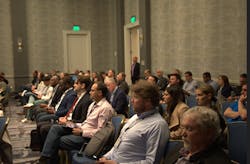All Eyes on Microgrids as Catalysts of the Evolving Energy Transformation: MGK Conference Day 1 in Baltimore
Only a few years ago, the nation’s utilities were forecasting flat load growth as efficiency technologies and reduced demand were rendering the need for new-build power generation obsolete. Oh, how that quaint era feels like gigawatts and ages ago.
What’s changed? Hmm, only the hyperactivity of hyperscale data center construction, the electrification expansion into transportation and demand of mission-critical facilities which require around-the-clock protection from breakdowns on the main grid.
Each of those sectors faces different challenges but seeks a common answer.
“For adding all that demand, the infrastructure just doesn’t exist; there isn’t enough generation,” said Joseph Martorano, Associate Principal of Arup, in one of Monday’s first-day sessions at the Microgrid Knowledge Conference at the Marriott Waterfront in Baltimore. “You can’t help but think of microgrids as being the solution.”
The future end-users for this new era of decentralized energy are many, from electric vehicle and fleet charging stations to hospitals, military bases, college universities, and beyond. The solution of microgrids may sound simple, and it is anything but, as standing-room crowds noted during the early sessions.
“There’s a lot of orchestration,” said Kristel Watson, Chief Commercial Officer for Scale Microgrids and a panelist in the session on university microgrids. “There’s a lot of parties you have to make happy.”
The utilities are not the enemy, for sure, but they and the historic grid infrastructure alone cannot match the expansion needed as an economy shifts to sustainable, more resilient, and decentralized electricity networks. Utilities have their role to play, but they are not the only players.
“The market trends now include decarbonization, decentralization, electrification, and digitalization. A lot of consumers rely on grid connection only, so they need backup power, especially in critical industries,” said Raman Ramireddy of Rolls-Royce in Monday’s Introduction to Value Creation with Microgrids session. “This trend is only going to increase in the coming years, according to our analytics, and a large portion of our customer base will begin to rely on backup power as the frequency of power outages increases.
The Time for the Evolution of Microgrids Has Come
As the Microgrid Knowledge Conference will detail over its remaining two days through Wednesday, these generation portfolios will include solar, battery storage, gen-sets with both fossil and biofuels and possibly even hydrogen and small nuclear as the scale of those resources evolves.
“Hydrogen will be hitting the grid at an increasing capacity, and we should see this, as well as other resources such as geothermal energy, starting to hit the network soon. This is going to change how we manage microgrids and test how these systems will mature,” remarked Sam Harrell of Intel Corporation.
An old joke in the industry, Spirae’s Co-Founder and CEO Sunil Cherian recalled in another Microgrid Knowledge session on value creation, is that “if you’ve seen one microgrid, you’ve seen them all.”
The old adage couldn’t be less true today as the complex future of the energy transition unfolds. Now more than ever, power generation is interconnected by parallel technologies ranging from artificial intelligence to control technologies and ever more economical renewable energy assets.
“The time has come for the evolution of microgrids, and we will see a lot of things come because of that,” Cherian added. “It raises the question of whether a microgrid is a ‘thing’ or a ‘catalyst.’ I believe it is a catalyzer because it will transform the way we think about energy cells, and they are the accelerator to transform the energy industry as we know it.”
Transformation is seen not only in the future but also in the projects currently on the ground or in the pipeline. Gallaudet University’s David Good and Mahmoud Kabalan of St. Thomas (Minnesota) Center for Microgrid Research focused on their campus microgrids, while leaders with Prologis Mobility and AlphaStruxure detailed their own work supporting fleet electrification and decarbonization.
The momentum for electric vehicles has certainly been slowed lately by various factors, from a slowing of buyer demand to public perception doubting future forecasts on transportation electrification. The stall in deployment is not because of a lack of solutions or interest in EVs but rather in how quickly and dependably charging infrastructure will roll out.
“We don’t see the lack of growth impacted by a lack of solutions. We have solutions,” JT Steenkamp of Prologis Mobility pointed out.
“People will build and buy those electric trucks,” Steenkamp’s co-panelist Martorano of Arup added. “The only thing stopping them is there is nowhere to charge them.”
In the Think Microgrid Policy Workshop, session chair Cameron Brooks illustrated the importance of these topics, stating, “One of the visions we here at Think Microgrid have is borrowed from the Department of Energy, which believes that ‘by 2035, microgrids are envisioned to be essential building blocks… reaching 30%-50% of the total generation capacity.’ But, if we’re really going to achieve this kind of scale, we need a diverse range of microgrids operating at different scales.”
Happening Tuesday at the Marriott Waterfront
The second day of Microgrid Knowledge Conference sessions will add more context on creating on-site power for transportation electrification. Other sessions will focus on topics from artificial intelligence to commercial supply chains, the role of utilities in microgrid development, the momentum of federal incentives such as the Inflation Reduction Act, and how to navigate the frustrations of interconnection delays in getting projects realized.
Tuesday morning’s Microgrid Knowledge Conference keynote will feature two key U.S. Department of Energy leaders for spurring microgrid development: Gil Bindewald and Katrina Pielli. The conference runs through Wednesday.
About the Author
Rod Walton, EnergyTech Managing Editor
Managing Editor
For EnergyTech editorial inquiries, please contact Managing Editor Rod Walton at [email protected].
Rod Walton has spent 17 years covering the energy industry as a newspaper and trade journalist. He formerly was energy writer and business editor at the Tulsa World. Later, he spent six years covering the electricity power sector for Pennwell and Clarion Events. He joined Endeavor and EnergyTech in November 2021.
Walton earned his Bachelors degree in journalism from the University of Oklahoma. His career stops include the Moore American, Bartlesville Examiner-Enterprise, Wagoner Tribune and Tulsa World.
EnergyTech is focused on the mission critical and large-scale energy users and their sustainability and resiliency goals. These include the commercial and industrial sectors, as well as the military, universities, data centers and microgrids. The C&I sectors together account for close to 30 percent of greenhouse gas emissions in the U.S.
He was named Managing Editor for Microgrid Knowledge and EnergyTech starting July 1, 2023
Many large-scale energy users such as Fortune 500 companies, and mission-critical users such as military bases, universities, healthcare facilities, public safety and data centers, shifting their energy priorities to reach net-zero carbon goals within the coming decades. These include plans for renewable energy power purchase agreements, but also on-site resiliency projects such as microgrids, combined heat and power, rooftop solar, energy storage, digitalization and building efficiency upgrades.
Breanna Sandridge, Senior Editor
Breanna Sandridge is senior editor for EnergyTech and Microgrid Knowledge, both part of the energy group at Endeavor Business Media.
Prior to that, Breanna was managing editor for Machinery Lubrication and Reliable Plant magazines, both part of Noria Corp. She has two years experience covering the industrial sector.
She also is a 2021 graduate of Northeastern State University (Oklahoma) with a Bachelor's in English.



